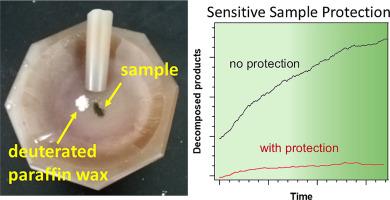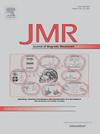用渗透石蜡在魔角纺丝下保护对空气/水分敏感的固体核磁共振实验样品
IF 1.9
3区 化学
Q3 BIOCHEMICAL RESEARCH METHODS
引用次数: 0
摘要
固态核磁共振(SSNMR)光谱是一种强大的材料表征技术,但其在空气和水分敏感材料中的应用往往受到魔角旋转(MAS)过程中难以保持惰性环境的阻碍。对于通常不提供紧密密封的快速mas转子尤其如此。在此,我们提出了一种通用的方法,采用渗透过氘石蜡- n-二十烷-d42和c-十二烷-d24作为保护包埋介质,使用SSNMR分析敏感的有机金属催化剂。我们证明这些蜡在MAS条件下显著减缓氧化降解。采用双量子过滤和交叉极化技术有效地抑制了蜡的弱背景1H和13C核磁共振信号。这些发现为将SSNMR的范围扩展到空气敏感系统提供了一种强大的方法,对反应材料和催化剂的结构研究具有重要意义。本文章由计算机程序翻译,如有差异,请以英文原文为准。

Protecting air/moisture-sensitive samples using perdeuterated paraffin wax for solid-state NMR experiments under magic-angle spinning
Solid-state nuclear magnetic resonance (SSNMR) spectroscopy is a powerful technique for materials characterization, yet its application to air- and moisture-sensitive materials is often hindered by the difficulty in maintaining an inert environment during magic-angle spinning (MAS). This is particularly true for fast-MAS rotors that do not generally provide tight seals. Herein, we present a generalizable approach employing perdeuterated paraffin waxes—n-icosane-d42 and c-dodecane-d24—as protective embedding media to analyze sensitive organometallic catalysts using SSNMR. We demonstrate that these waxes significantly slow oxidative degradation under MAS conditions. Weak background 1H and 13C NMR signals from the waxes are effectively suppressed using double-quantum filtration and cross-polarization techniques. These findings offer a robust method for expanding the scope of SSNMR to air-sensitive systems, with implications for the structural study of reactive materials and catalysts.
求助全文
通过发布文献求助,成功后即可免费获取论文全文。
去求助
来源期刊
CiteScore
3.80
自引率
13.60%
发文量
150
审稿时长
69 days
期刊介绍:
The Journal of Magnetic Resonance presents original technical and scientific papers in all aspects of magnetic resonance, including nuclear magnetic resonance spectroscopy (NMR) of solids and liquids, electron spin/paramagnetic resonance (EPR), in vivo magnetic resonance imaging (MRI) and spectroscopy (MRS), nuclear quadrupole resonance (NQR) and magnetic resonance phenomena at nearly zero fields or in combination with optics. The Journal''s main aims include deepening the physical principles underlying all these spectroscopies, publishing significant theoretical and experimental results leading to spectral and spatial progress in these areas, and opening new MR-based applications in chemistry, biology and medicine. The Journal also seeks descriptions of novel apparatuses, new experimental protocols, and new procedures of data analysis and interpretation - including computational and quantum-mechanical methods - capable of advancing MR spectroscopy and imaging.

 求助内容:
求助内容: 应助结果提醒方式:
应助结果提醒方式:


